What Is A Digital Denture?
Exceptional Digital Dentures for National Partners
Global Dental Solutions is at the forefront of manufacturing digital dentures. Modern dentistry involves technological advancements, and one of those has been the digitization of denture fabrication. Digital dentures, depending upon the application, allow dental professionals to more precisely match an existing denture, speed up the time necessary for specific stages, or decrease the number of stages required. Through collaboration, education, and the mutual goal of superior patient care, we can pave the way for a new era in dentistry where digital dentures are the benchmark for success.
What Are the Key Components of Digital Dentures?
Global Dental Solutions offers digital dentures, using intraoral scans submitted by Clinicians. Creating these digital dentures differs from traditional processes, as it can provide an exact copy of an existing denture, or allow an exact copy of an existing denture that has a PVS reline impression inside of it. Here is what dental professionals can expect from our digital process:
- Digital Scanning: The process generally begins with 3D intraoral scanning. This is where high-resolution digital images are captured to precisely map the patient’s oral cavity. The digital scanning step reduces the need for standard analog impressions. Patients can experience lessened discomfort, and dental professionals can reduce potential errors, as long as scanning protocols are followed and the scans are reviewed for accuracy before submission.
- Computer-Aided Manufacturing (CAM): Our CAM system uses 3D printers to create digital dentures. This step moves the digital design into the actual prosthetic.
- Computer-Aided Design (CAD): We then use the Intraoral scan to create a model of the patient’s mouth. Depending upon the desired next step and the product being ordered, we will either begin the “Copy Denture” process of making a replica of the existing denture, or we will print the model and make the “baseplate + rim” or the “denture tooth setup” stage.
- Placement: A dental professional can then place the digital denture in the patient’s mouth. Adjustments can also be made in the same manner as a traditional, analog impression denture.
What Are the Benefits of Digital Dentures?
Dental professionals Nationwide who are considering the use of our digital denture services can gain significant benefits. Here are some of the advantages of offering digital dentures in a dental practice:
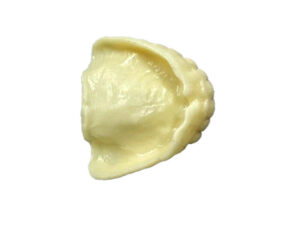
Tooth color Copy Denture try in.
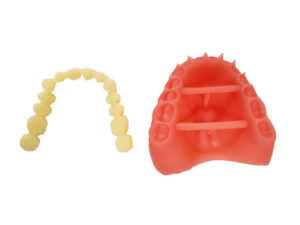
The individual parts of the printed denture. The teeth are printed as one piece and the base is printed as one piece.
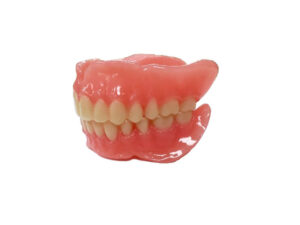
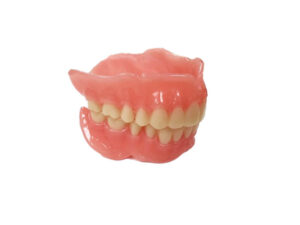
The individual parts of the printed denture are bonded together with a light cure procedure.
- Accurate Fit: Digital dentures offer an excellent and precise fit when the scanning protocols are followed and the oral cavity allows for it. As holds true for conventional dentures from analog impressions, the oral cavity must have proper structure for retention. A digital denture will not provide more retention than a denture from a conventional impression if the patient’s ridges and flanges do not allow for a sufficiently retentive denture. A well-fitting denture can improve comfort and speech functionality. A dental professional can market their dentures as being digital and more technologically advanced than other methods, enhancing patient experience through the use of the IOS (intraoral scanner).
- Accelerated Workflow:Creating dentures digitally can help accelerate a dental office’s workflow. The production of digital dentures streamlines the workflow and allows dental practices to offer quicker turnaround times by saving the 1 day required for shipping to the laboratory, and the potential saving of various steps in the manufacturing process. This process decreases the wait time for patients to receive their final denture(s).
How Does the Digital Denture Process Work?
Understanding the process is essential to a successful outcome. Here are the steps that a patient goes through during their digital denture process:
- Consultation and Scanning: Once the patient agrees to the treatment plan, a digital scan is taken. These scans capture the patient’s current oral structure.
- Custom Design Creation: After scans are completed, they are sent to us here at Global Dental Solutions. If a bite scan is not provided, we fabricate a baseplate + rim and send the printed model work and baseplate + rim to your office for a bite registration with the standard procedures. If a bite scan is provided, we can skip the baseplate + rim stage and proceed to the tooth setup stage. We consider aspects such as mouth shape, size, and any preference the patient has expressed to their dental professional to choose the appropriate mold (shape and size) for the denture setup. If there is an existing denture that the patient wants to replicate as closely as possible, an additional scan of the existing denture can be taken and provided to us for reference and measurement of those teeth.
- After the Bite Registration or Try-In Stage: After the bite registration stage (using the baseplate + rim) or the tooth setup try-in stage, the denture proceeds to the same next steps as a denture made from an analog impression would proceed.
How Do We Replicate Existing Dentures for Your Patients?
At Global Dental Solutions, we offer replications of existing dentures your patient may have. When a patient wishes to replicate an existing denture, a “digital copy denture” can be created by scanning the intaglio and outside surfaces as one file. After submission, we will print the acrylic denture base and print the teeth as a single piece from Dentsply IPN resin, which will then be luted together and delivered to your dental practice. We call these “Copy Dentures.” It should be understood that if the existing denture has worn teeth, etc., the “copy denture” will reflect the same. One modification that can be made to a “digital copy denture” is the intaglio surface. If the inside of the denture is loose and needs a reline, the copy denture can accommodate this. In this instance, a wash impression can be made, and the denture scanned as previously described, ensuring that the intaglio of the copy denture reflects the wash impression. When the wash impression is taken, please be sure to check the occlusal relationship to ensure the wash impression has not affected the vertical dimension, thus resulting in an open bite in areas. Another option for copy dentures is to modify the existing worn teeth to “as new” teeth with ideal cusps and lengths. To accomplish this, an additional scan of the opposing and a bite scan is required. If desired, we can send a printed try-in for occlusal and esthetic check before the printing of the final altered copy denture. The printed try-in denture will be completely shade A1 and is for try-in only.
If changes are needed to the tooth color printed try-in, such as with the occlusion, gumline location, etc., the Clinician can return it to the lab with physical bite registrations and/or markings on the try-in using a permanent marker, for the case to be remounted or modified for a new try in or finish. Alternatively, the try-in can be adjusted and marked up as needed in the office, then rescanned (the denture itself and if needed, a bite scan) and submitted digitally to be modified for a new try-in, or finish.
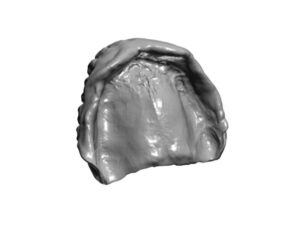
Existing upper denture with a wash impression taken inside by the Clinician.
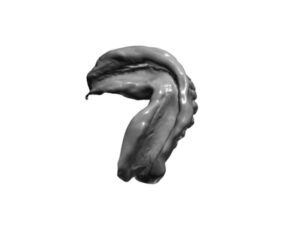
Existing lower denture with a wash impression taken inside by the Clinician.
What Are the Challenges of Adding Digital Dentures to Your Practice?
Adding digital dentures to your practice allows for quicker turnaround, enhanced customer satisfaction, and more. If you already have an IntraOral Scanner, this should be relatively seamless to your existing workflow. While there are many positives to choosing digital dentures for your practice, we understand some may face challenges when making the switch. Discover how our team can help you overcome these challenges to provide better patient satisfaction. Here are some of the ways we can help dental practices overcome these challenges:
- Technological Integration: One area where our team can guide your practice is the integration of the scanning systems used in digital dentures. This challenge may involve investing in new technologies and providing advice regarding training to use the tools involved.
- Patient Education: Patient education is key to adding these dentures to your dental practice. Dental professionals should communicate the benefits and limitations of digital dentures to manage their patients’ expectations and experiences.
- Cost Considerations: Consider the cost of digital dentures before implementing them at a dental practice. Cost considerations are important for both dental professionals and their patients. Evaluate the financial implications and communicate the value to dental patients, staff, and other stakeholders.
Are There Different Types of Digital Dentures?
At Global Dental Solutions, we offer a variety of dentures, including fixed detachable, attachment retained, and normal removable. Here are some of the key differences between removable dentures, screw-retained dentures, and hybrid models:
- Removable Dentures:These dentures are designed to be taken out of the mouth by the patient. Removable dentures are secured into a patient’s mouth by natural suction or a dental adhesive when the intraoral conditions do not allow for natural suction.
- Overdentures: Overdentures offer retention for patients suffering from retention problems with the typical complete denture, particularly those patients with advanced ridge resorption. Overdentures obtain their support from two or more attachments. (The use of only one attachment is not recommended.) Overdentures offer these patients greatly improved retention and stability. The overdenture attachment can be placed in tooth roots that have been saved or torqued into dental implants that have been placed to receive them. Overdentures are removable from the mouth by the patient.
- Fixed Detachable /Hybrid Dentures: The treatment using screw-retained dentures on four or more implants was developed to provide edentulous patients with an efficient and effective restoration using only four implants to support a full arch prosthesis. Our screw-retained dentures on four or more implants are fabricated utilizing a milled titanium bar and premium-grade resin teeth. Fixed detachable dentures could also be fabricated using cast or milled internal metal mesh and Ti-cylinders cured inside the acrylic, which then screw directly to the implants, or to Multi-unit Abutments. Premium-grade teeth are required because fixed detachable dentures take much more load than standard dentures.
Contact Global Dental Solutions to Discuss Digital Dentures
At Global Dental Solutions, we offer digital dentures for dental professionals and their patients. A digital denture starts with digital technology, enabling dentists to offer a quicker denture solution and additional options, such as the Copy Denture. Dental professionals enhance clinical outcomes, increase practice efficiency, and amplify patient care by offering this edentulous solution. Whether dental practices need standard dentures or overdentures, our team can help. Our superior communication can benefit our clients nationally. Contact us today to learn more about implementing digital dentures into your dental practice.
